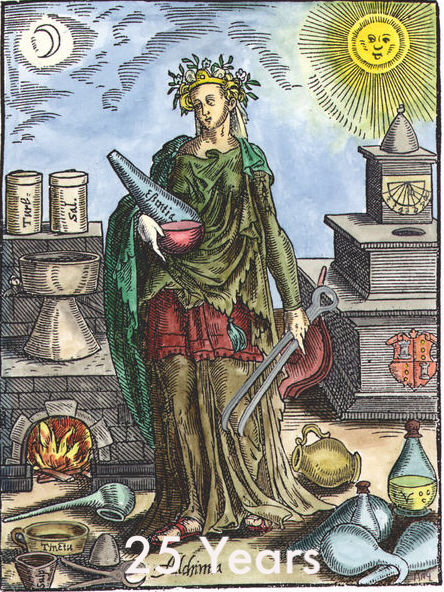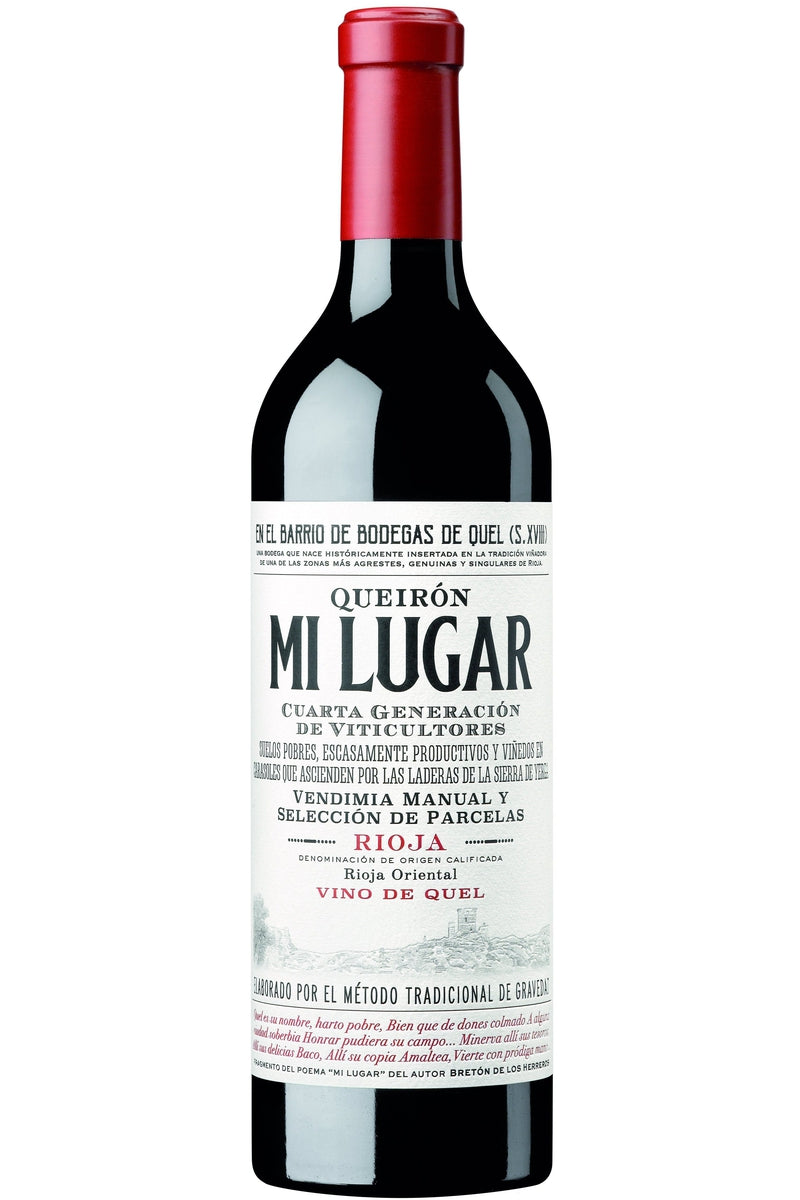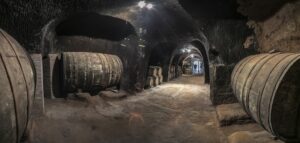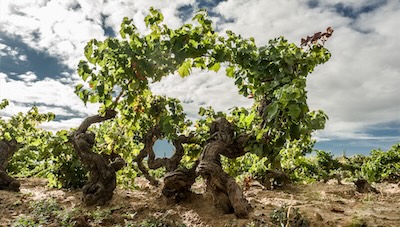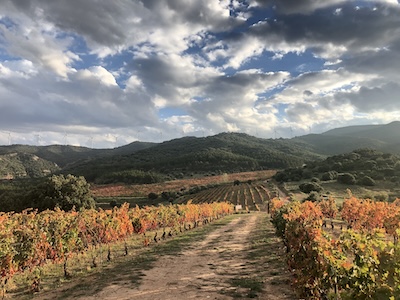Mi Lugar Rioja from Bodega Queirón is WOTY 2023
The Wine of the Year (WOTY) 2023 award from Wine Alchemy goes to Bodega Queirón in Spain for their extra-special red wine, Mi Lugar Rioja DOCa, 2018.
As is usual, the Wine Alchemy WOTY must be inspirational. Exceptional taste is a given. But, in addition, the winning wine must be genuinely sustainable, express terroir and the winegrower’s philosophy, and be available to buy in the UK. In short, any WOTY must be a wow!
Having tried this wine several times this year, I put my money where my mouth is and bought it, some for drinking now and some to keep.
Bodega Queirón makes Mi Lugar in the Rioja Oriental subzone of Rioja DOC, and blends Tempranillo and Garnacha. Mi Lugar means “my place”. This name proves to be an apt description. We’ll also see that it has impeccable sustainability credentials and shines a light on where it comes from.
Rioja Oriental
Being the most easterly subzone of Rioja, the Mediterranean influences the climate in Rioja Oriental much more than the Atlantic Ocean. This means it’s semi-arid, hotter and sunnier than the other two subzones. Therefore, altitude and the diurnal variation that goes with it are vital in keeping acidity in the grapes and, hence, freshness and balance in the resultant wine. Furthermore, the red Soils here are predominantly thin sands and loams rather than the clays and chalks typical of the other two subzones.
Wine development in Rioja Oriental has historically lagged behind the Alta and Alavesa subzones. Those two contain many of the best-known Bodegas and had historically superior access to the Atlantic at Bilbao. Rioja Oriental became a place where small growers and local cooperatives were dominant.
Consequently, some saw the Rioja Oriental as the inferior zone, despite wineries from further west often buying their grapes. Perhaps that was reason enough for the controversial name change from Baja to Oriental in 2018. Or, the explanation is more straightforward: the word Baja (low) sounds inferior to Alta (high).
Put any prejudice aside because some of Rioja’s most exciting wine developments recently have been in Rioja Oriental. One of these is Bodega Queirón, located in the small town of Quel.
Quel
The name Quel comes from Arabic (qalat), meaning castle, the remains of which rise high above the town. The first written records of wine growing here were in 1327, but archaeology shows its origins date back to the Roman conquest, a century before Christ.
Quel straddles the Rio Cidacos, and along the river’s south bank are more than 350 caves. By the Eighteenth century, these caves had become known as the Barrio de Bodegas, a name that survives today. Families made wine in them in the days before Phylloxera. Not only did this network of caves make ideal cellars, but natural chutes from the cliff tops conveniently allowed the grapes to fall directly into the caves by gravity.
After Phylloxera, challenging economic conditions persisted, and many locals left the area. 1947 saw a wine cooperative founded in Quel. This allowed many families to sell their grapes to it for a more stable income. Over time, the caves became abandoned or put to other uses, such as housing. Now, the Barrio de Bodegas has wine-making once again.
Quel is also known for the high quality of its old-vine Garnacha, which thrives in this harsh environment. Queirón has a plot of Garnacha vines planted in 1892! Locally, much Garnacha was replaced with Tempranillo, which was more productive and reliable, especially useful when growers were paid by quantity rather than quality.
However, the local Tempranillo is also excellent, as it grows at some of the highest points of the entire Rioja DOCa.
Consequently, Tempranillo and Garnacha from these parts are now highly prized locally and by the Bodegas of Rioja Alta and Alavesa.
Bodega Queirón
Gabriel Pérez Cuevas launched Bodega Ontanón in 1985 in the Rioja Oriental. This highly successful Rioja brand now has wineries in Spain’s Rioja, Rueda and Ribera del Duero regions. Bodega Queirón is the Pérez Cuevas family winery project in Quel, run by the fourth generation. A new winery uses the ninth cave in the Barrio de Bodegas. Gabriel Pérez Cuevas was born in Quel, knew its potential and started planning a new Bodega there in 2010.
All the Queirón vineyards are certified organic or transitioning to it. These are all at Quel, between 600 and 800 metres elevation, comprising 25 parcels of dry-farmed bush vines. These mostly face south, high up on the slopes of the mountainous Sierra de Yerga, where conditions are much harsher and the soils stonier than down on the lower plains.
Tempranillo, Garnacha, and Graciano are grown for the red wines (Tinto), while Tempranillo Blanca is for the whites (Blanco).
Mi Lugar is one of Queiróns six wines. They feature innovations such as single-varietal wines, maturation in Tinajas, no added sulphur, and even sun-dried grapes. Consequently, this is a range worth exploring.
Sustainability includes zero emission goals, solar power and ensuring biodiversity, wastewater management and biological pest control. No machinery is used in the vineyards. Indeed, vine prunings are not burnt. Instead, they are ground up and recycled, reducing fire risk and preventing CO2 emissions.
Mi Lugar
Mi Lugar cleverly uses written descriptions in contrasting fonts as a label design – a stylish way of presenting much information about the wine, albeit in Spanish and with terms that may be unfamiliar, even to Rioja lovers.
This wine is classified as a Vino de Municipio, hence, in this case, Vino de Quel. This classification applies to 145 municipalities across Rioja DOCa. Superficially, it resembles a Burgundy village classification. The idea is that the wine is a product of a specific place or terroir. Contrast this to the usual Rioja model, where the wine may be made from grapes from across the Rioja region and which is defined by maturation time rather than location.
Though this classification adds more complexity to the Rioja rules, it also encourages stylistic diversity. Furthermore, it resembles the vinos de pueblo category established in other Spanish regions.
Under this law, the winery must be located within the municipality. This may seem curious, but it enables the winery to build the local village profile and status. In addition, it must also mature and bottle at least 85% of the wine from vineyards within the same municipality. Mi Lugar is 100%.
Technical details
Mi Lugar is an organic wine that blends 90% Tempranillo and 10% Garnacha. Bodega Queirón owns all five high-altitude Quel plots from which the grapes for Mi Lugar are selected. The Grenache grows high, at an altitude of 620 metres, and the Tempranillo is even higher at 670 metres.
Three separate grape selections ensure only the best grapes from each vineyard. The first selection is made in the vineyard when hand picking, the second after destemming the bunches at the winery, and the third on a sorting table. Respecting local tradition, the new winery is gravity-fed and connects to the ninth cave in the Barrio.
A cold maceration lasts five days before fermentation for eighteen days at 22-26ºC. The secondary (malolactic) fermentation occurs in oak barrels, where the wine matures for eighteen months. 20% of the oak barrels are US, with 80% French. Moreover, while each barrel is “first use”, each has a different toasting level, offering a range of oak influences. After blending, the wine ages for another six months in large wooden vats before bottling.
You’ll look in vain for those more familiar Rioja maturation designations like Crianza, Reserva and Gran Reserva. This wine focuses on its origins rather than how long it has matured in the barrel. Instead, it’s released when it’s ready to drink.
Tasting
Mi Lugar cleverly uses written descriptions in contrasting fonts as a label design – a stylish way of presenting much information about the wine, albeit in Spanish.
This 2018 example of Mi Lugar is the second vintage. It was decanted for 30 minutes before serving, not because of sediment, but to allow the wine to open up, given its relative youth. However, this is optional as it’s ready to enjoy straight from the bottle.
In the glass, a bright red cherry colour. The aromas deserve to be lingered over; be in no rush. Initially, a little smoke from the oak, with an intensity of plum, blueberry and bramble fruit. A savoury balsamic note lurks beneath and gradually reveals itself as the wine opens in the glass. There’s only a hint of vanilla – the oak treatment is subtle and doesn’t intrude on the nose or palate. Instead, it just adds depth and extra complexity.
Now for the taste. At 14.5%, this wine can take oak in its stride, though that alcohol level never intrudes. Instead, it perfectly balances the fruit, the bright acidity and the fully integrated tannins. There are no sharp elbows, greenness or grain here. Garrigue-ish notes (the Spanish call that Tomilar) with Mediterranean herbs suggest warmth and wildness, while some wood spices appear on a long mineral fade.
This is a fabulous, graceful wine which enthrals. It’s drinking perfectly now, and I’ll wager it will develop magnificently over the next 10-15 years. I’m certainly looking forward to confirming that!
Food
As for food, pairing Rioja and Lamb might be a cliche, but that’s because it works. Instead of breaking out the mint sauce, try it with rosemary, juniper berries and some thyme. Mushrooms make an excellent vegetarian alternative. For something authentic, try this recipe for Patatas a la Riojana.
UK Availability
Mu Ligar has excellent UK Availability and is outstanding value. Here are ten examples of where to find it at independent merchants, listed in alphabetical order:
Cambrian Wines £23.00
Cheers Wine Merchants £22.45
Hattersley Wines £22.50
Kwoff, £26.49
ND John £25.00
Noble Green Wines £25.50
Reserve Wines £26.50
Alternatively, contact the importers, Boutinot.
And Finally
Let’s finish with a final label reference from a Spanish poem about Quel called Mi Lugar, which doubtless inspired the name of this wine. It’s by Manuel Bretón de los Herreros (1796-1873), a Spanish playwright born in Quel. In English, it says something like,
Quel is its name, full of the poor but replete with gifts…Minerva is there with her treasures, and Bacchus is there with his earthly delights.
Wine and wisdom. That works for me.
Location
Bodega Queirón – Viñedos Familiares
Bodega Nº 9
Barrio de Bodegas de Quel
26570 Quel
La Rioja
España
What3Words Location
Thanks to Bodega Queirón for the background information and photography and to the Consejo Regulador Rioja for the subzone map.
Accordingly, all the previous WOTY winners are here: 2022, 2021, 2020, 2019, 2018, 2017 and 2016.
